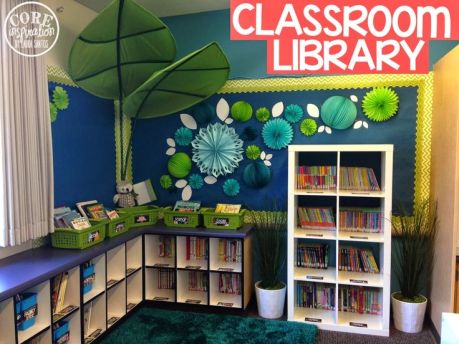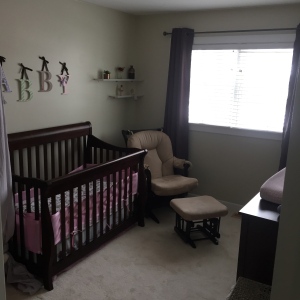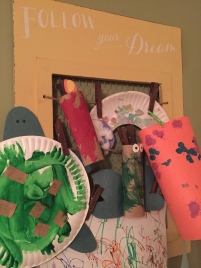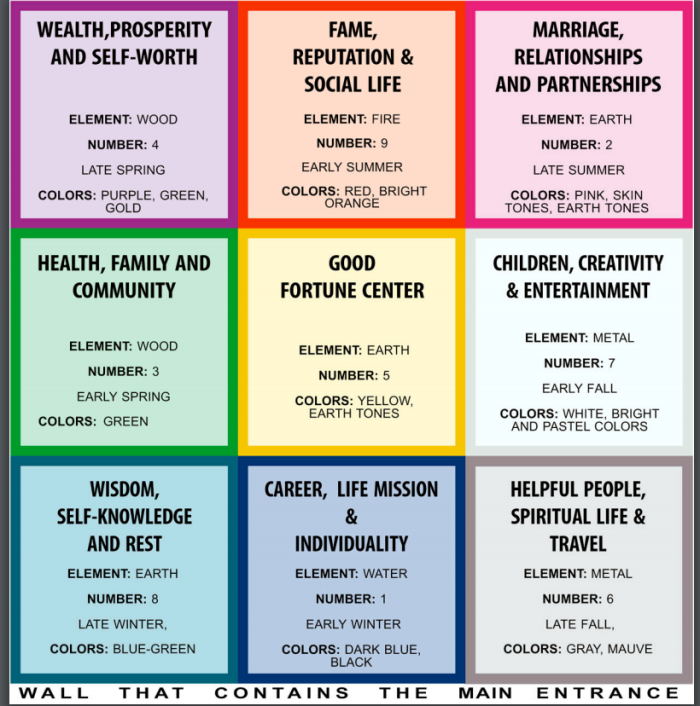If you could have the perfect life, what would it look like? Imagine your life exactly as you wish it could be. Now, what if I told you that you were given these unique desires because you were meant to fulfill them? You are meant to fulfill your dreams and accomplish your goals. How, you ask? Feng shui can help!
What exactly is feng shui?
You have the power to change nine areas of your life with the help of feng shui. Using a tool called the bagua map, you will be able to see which area of your home, office, or classroom connects to specific areas of your life. The nine areas are: wealth, reputation, relationships, children & creativity, health, family, knowledge, career, and helpful people & travel. Using the bagua map, you can address any area of life and see results almost immediately.
Ideally, a feng shui home will have good flowing energy in all nine areas. However, just as life is ever-changing, so must your feng shui practice continue to evolve. Once you declutter a space and decorate, you will need to check in on that area of your home from time to time to keep it healthy. The knowledge of feng shui is a very powerful tool that you can use as situations arise in your life.
When you are ready to start applying feng shui to your classroom (or office), decluttering and organizing is a great place to start! First and foremost, you want to tend to your personal desk. Then, it is most important to organize the furniture, such as student desks and tables, in a way that allows optimal flow of chi. Finally, help your students organize their personal desks and the materials in the classroom so that you feel more energized and peaceful in your classroom. Let’s get started!
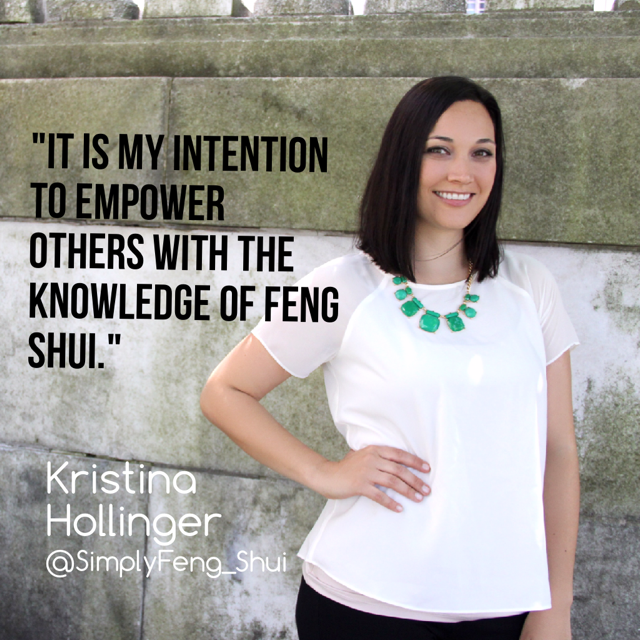
Step One: Clear Desk, Clear Mind
Did you know that you could lay the bagua map on your desk? That’s right, you can elevate the energy of all nine areas of your life simply by cleaning and organizing your desk with your intention.
If you are like most teachers, you probably do not spend that much time in your desk. However, when you are at your desk you are probably doing some important documentation or planning that needs your full attention. Make your desk inviting and clear so that your mind feels lighter and you can focus with greater ease.
-
Empty each drawer one at a time. Drawers carry very stagnant energy because there is nowhere for the energy to escape. The best way to refresh the energy of the desk and release old chi is by removing objects and getting rid of what you no longer need. There are probably many teachers or students who could benefit from some old supplies that you no longer use.
-
Now that your desk has been organized, you are ready to minimize the surface of the desk. Start by taking everything off and dusting the surface of the desk. Next, place your items strategically based on the bagua map and the elements which represent each gua. For example, I like to place a bamboo plant on the upper left corner of my desk. The upper left gua is the wealth gua, activated by the wood element. The bamboo symbolizes wood and represents upward growth. The hollowness of the bamboo signifies the openness to receive abundance. The chart below shows the bagua map and suggestions for each gua. Remember that the element is most effectively represented by the shape.
-
Place the desk in a “power position.” You want to able to see the door from where you are sitting. If your back is against the door, you could get startled if someone walks up behind you. You have more peace of mind knowing exactly who is entering your space. Try to have a solid wall behind you if possible. This school year, I moved my desk from the relationship corner to the wealth corner. Those are the preferred guas since they are considered the most powerful, anchoring positions. Although there is a window at my back, I have a much better view of the door. If your desk has been in the same position for a couple years, I would recommend simply turning the desk to face another direction. Whenever you move furniture, it freshens the chi and gives you a new perspective on life and your classroom.
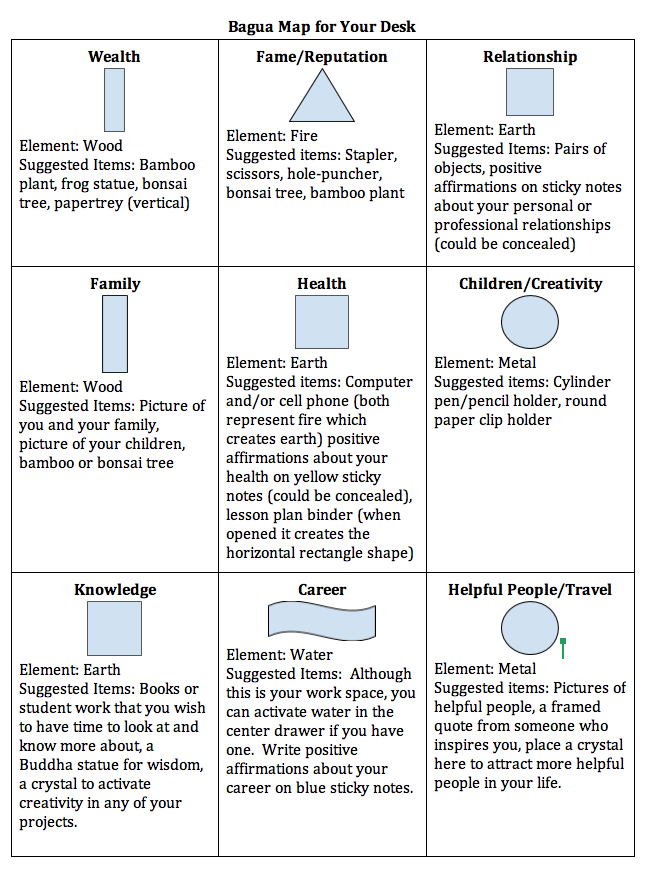 Caption: If you are conscious of the bagua map as you organize your desk and classroom, it will help you create greater harmony. The bagua map is the same as the one you place on your house, but there are some additional suggestions on how each gua specifically affects your classroom or career path.
Caption: If you are conscious of the bagua map as you organize your desk and classroom, it will help you create greater harmony. The bagua map is the same as the one you place on your house, but there are some additional suggestions on how each gua specifically affects your classroom or career path.
Step 2: Furniture Arrangement: Creating Optimal Flow in Your Classroom or Office
You started organizing your desk, and placed it in a power position. Now, you can arrange the rest of furniture for the greatest flow of chi. You and your students will be able to focus better when the energy circulates unobstructed through your classroom. Before you start moving everything around in your classroom, there are some key points to remember when arranging your space:
Round is the Way: Chi flows best around rounded edges. If you arrange desks in a formation that creates a lot of straight lines and sharp turns, the energy will not flow as well.
Energy as a Stream: Energy is constantly moving in a forward motion. The energy flows in each time you open your classroom door. Imagine the energy as a stream of water. As it flows in through the classroom, where does the water flow quickly? Does it get stuck in a certain space? Try to arrange the space as best as you can so that the “water” flows does not get blocked. This is another reason why opening up a window at least once a week is important. When you open the window, it allows stagnant energy to exit, and refreshing chi enters to revitalize your space.
Mountain Behind You: You want a mountain behind you. As the instructor, you need the power position so that you feel confident when working with the students. I have a couple of tables in my classroom where I meet with small groups of students for literature discussions and other activities. I have placed my chair so that my back is to the wall, and I have a unobstructed view of the whole classroom. In particular, you should be able to see the door from where you sit.
Use the Elements: As you decide where to place furniture, remember that each gua is best activated with a specific shape. One of the tables I use for small group instruction is a kidney shape. The rounded shape could represent metal, so I placed this table in the Children & Creativity gua. Another big table is a long horizontal rectangle. This shape represents the Earth Element, and it is placed in the relationship corner with an even number of chairs. The relationship corner is best activated with pairs of objects, or even numbers. This promotes partnership and successful collaboration.
No Space is Ever “Fixed” for Good: Although your classroom can stay in the same formation all year, it is best for students to switch desks every four or five weeks. Even if the desks are in the same formation, the simple movement will boost the energy. Additionally, your students will appreciate the change of perspective. They will be more alert and recharged. You could even shift your desk if you are starting to feel drained in your day-to-day activities.
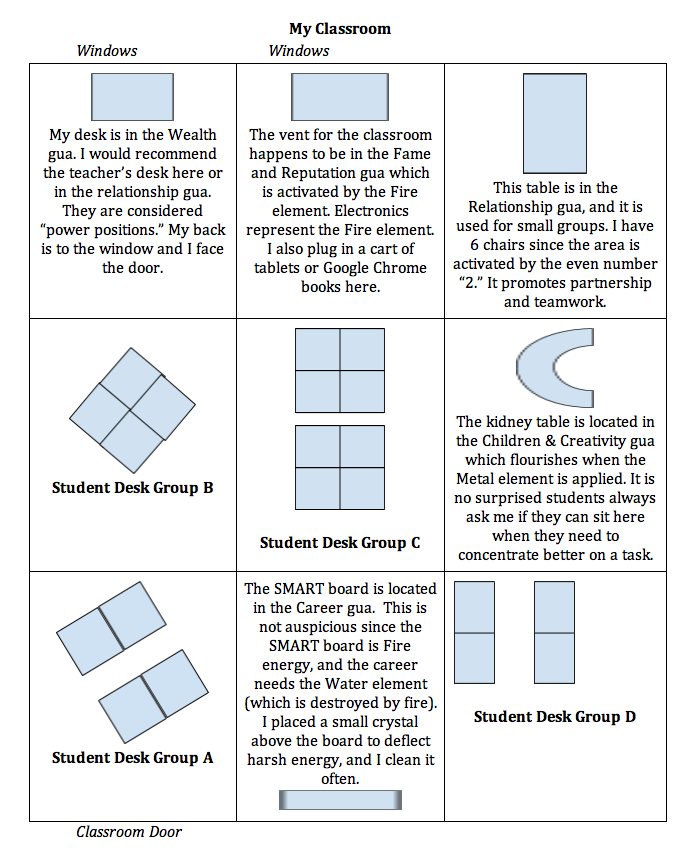 Caption: Every classroom is different, but here is an example of how I strategically arranged my classroom this school year. I used the elements, and the five suggestions above to help me make my design choices.
Caption: Every classroom is different, but here is an example of how I strategically arranged my classroom this school year. I used the elements, and the five suggestions above to help me make my design choices.
Student Desks:
Group A: The students are on an angle so that it creates a more “rounded” configuration. This allows the chi to flow. All students are facing the SMARTboard and can see the front door. The students are not in a group of four, but they all have a partner. When I want students to work in groups, they can move to the large work tables or turn their chairs. An additional note: Try not to have students in line with the door. As chi enters the door, the energy rushes in. Group A is not recommended for your students who are hyperactive or have difficulty concentrating. This space has active chi because of the door, so keep this is mind when sitting students here.
Group B: This group of four students are on an angle so that nobody has their back to the SMARTboard and everyone can see the door. Again, the angle also helps the energy flow.
Group C: The two groups in the center of the room have their backs to the East and West walls. Everyone can see the door. Although no one is facing the door or SMARTboard, if they look to the side they can see them. The group is not angled, but the center of the room is a “grounding” point. The center is the Health gua, and it is represented by the Earth. The desks create the square/horizontal rectangle which represents the Earth element.
Group D: All students in group D have their backs to the wall. The solid wall creates a “mountain” behind them. It is very auspicious any time you can have a solid wall or chair behind you. The solid back creates support and boosts confidence and productivity.
Checklist for Student Desks
-
Is there a solid wall behind you and your students?
-
Can your students see the front door?
-
Do the desks allow optimal flow of chi, or are they creating sharp turns?
Step Three: Getting the Students Organized
You have worked hard to clear your classroom of unnecessary clutter and arrange the furniture for optimal energy flow. Now, the key is to stay organized and keep your classroom functioning at peak efficiency. Here are three quick tips that will help the students take ownership of the classroom and accept the responsibility of maintaining the positive vibes. If you are a teacher who is evaluated based on the Charlotte Danielson framework, this area could be used as evidence of managing your classroom environment!
Friday Desk Cleaning: It sounds so easy, but how many times do you allow your students to clean out their desks? We get so busy, that sometimes this only happens once a quarter! Try to give your students 10 minutes every week to clean out their desks. The mess in their desks is causing unnecessary chaos in their minds. When the students have time to organize their personal space, they will be more efficient, remember their homework, and feel calmer. In addition, when all of the desks are organized, the overall chi of the classroom is improved.
Classroom Jobs: Many teachers assign classroom jobs. Do you have have the students dust the book shelves, counters, and common-area tables? My students love doing these types of jobs. Use whatever products your school approves, and notice how much fresher the room feels. Your classroom’s chi will be heightened immediately. Again, I would recommend
doing this weekly. If possible, open up the windows at the same time the students clean the surfaces. This will really boost the effectiveness as you let fresh air elevate the chi.
Explicit Organization: Do you spend time with your students finding a “home” for every school supply? Students need direct instruction on exactly where everything goes. At the beginning of the year students put all of their pens, pencils and erasers in their pencil pouch, and they learn that their scissors, glue and crayons belong in their art box. During our Friday Desk Cleaning day, we review where everything goes. My famous line is, “There should be no loose papers in your desk. Remember, everything has a home. Put papers in your ‘Take Home’ folder that need to go home. Place papers that you still need in your ‘Stay at School’ folder, and anything that you don’t need can be recycled.” Even high school students need reminders of how to organize their space. They too need to understand the value of keeping their personal space clean and organized.
For optimal results, I really encourage teachers, or anyone looking to improve their career, to try feng shui in their homes too No matter how neat and organized your classroom or office is, if you are coming home to disarray, you will not feel rejuvenated for the next day of teaching. We need to feel like our house is giving us a big warm hug every time we walk into the door. If you have a strong foundation at home, your professional life will start to fall into place.

